Coral reefs are home to any creatures. These are Herbivores in the Coral Reefs including the types, characteristic and conservation.
1. Parrotfish
Parrotfish are colorful and voracious herbivores. They spend up to 90% of their day eating algae off of coral reefs with their beak-like teeth. They poop sand up to 200 pounds of it per year keeping beaches beachy. These are some species of parrotfish.
a.) Bicolor Parrotfish
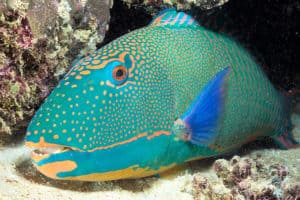 Bicolor Parrotfish (Cetoscarus bicolor) lives in the Red Sea. This species usually can be found in lagoons and seaward reefs at depths between 1 and 30 m. Bicolor Parrotfish is one of the largest parrotfishes, growing to a length of up to 88 cm.
Bicolor Parrotfish (Cetoscarus bicolor) lives in the Red Sea. This species usually can be found in lagoons and seaward reefs at depths between 1 and 30 m. Bicolor Parrotfish is one of the largest parrotfishes, growing to a length of up to 88 cm.
Since this fish is a sequential hermaphrodite, it starts as female (known as the initial phase) and then changes to male (the terminal phase). For the initial phase, its color is dark brown with a large cream patch on the upper part of the body.
The terminal phase is quite colorful, it’s overall green with pink spotting to the body and edging to the fins. The color of the juveniles is white with a black spot on the dorsal fin and an orange band through the eye. This parrotfish primarily feeds on algae.
See also:
b.) Dotted Parrotfish
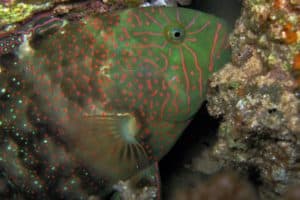 Dotted or viridescent parrotfish (Calotomus viridescens) is a species of parrotfish native to the waters of the Maldives, and the Red Sea, from the Gulf of Aqaba to south to the Chagos Archipelago. The head and body colors are gray-brown with darker scale edges, paler ventrally. The dotted parrotfish can reach the length 21 cm at maximum.
Dotted or viridescent parrotfish (Calotomus viridescens) is a species of parrotfish native to the waters of the Maldives, and the Red Sea, from the Gulf of Aqaba to south to the Chagos Archipelago. The head and body colors are gray-brown with darker scale edges, paler ventrally. The dotted parrotfish can reach the length 21 cm at maximum.
The species inhabits coral and rocky reefs and grass bed areas to depths of about 30 m. It grows singly or in small groups. The main feeds are marine angiosperms and epiphytic algae. They are caught mainly with traps, nets and other types of artisanal gear.
See also:
c.) Queen Parrotfish
 The queen parrotfish (Scarus vetula) is a medium sized parrotfish that inhabits coral reefs in the Caribbean Sea and its adjacent waters. The parrotfishes have powerful beaks, formed from the fusing of the teeth into biting plates. The largest queen parrotfish are brightly colored (blue, green, orange, etc.). The species gets its name from a series of markings on the head, above the eye, that looks like a crown.
The queen parrotfish (Scarus vetula) is a medium sized parrotfish that inhabits coral reefs in the Caribbean Sea and its adjacent waters. The parrotfishes have powerful beaks, formed from the fusing of the teeth into biting plates. The largest queen parrotfish are brightly colored (blue, green, orange, etc.). The species gets its name from a series of markings on the head, above the eye, that looks like a crown.
Juveniles and young adults colors are a somewhat drab and brownish. The unique behavior of this species is broadcast spawning, where females release eggs and males release sperm into the water column above the reef, at the same time.
Until today, parrotfish’s number has decreased due to overfishing. The Caribbean reefs where the parrotfish belongs have gotten increasingly furry with algae over the past for decade, resulting in a far less magnificent picture, and a far less productive and resilient ecosystem. Protecting parrotfish and urchins can help restore coral reefs. It can be done locally and does not require global coordination and cooperation. Algae prevent the growth of coral, so making sure there are plenty of parrotfish grazing the reefs can help coral recover.
See also:
2. Damselfish
The damselfish family contains a great number of species living in warm seas worldwide. They play various roles including territorial algal farmers, planktivores, and partners living commensally with sea anemones. Below are some species of damselfish.
a.) Cocoa Damselfish
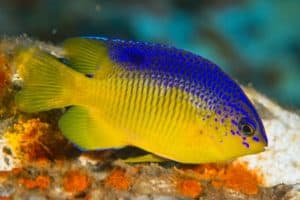 Cocoa damselfish live at the front of reefs rich in coral growth around 1 – 30 m widespread the Western Atlantic & Caribbean. They are sometimes aggressive when guarding their eggs.
Cocoa damselfish live at the front of reefs rich in coral growth around 1 – 30 m widespread the Western Atlantic & Caribbean. They are sometimes aggressive when guarding their eggs.
The color varies usually with a dark tail spot. They reach up to 13 cm in length. Adults feed primarily on benthic algae but also on sponges, ascidiacea and anemones, while juveniles’ diets are invertebrates such as harpacticoid copepods and nemerteans.
Meanwhile, in the breeding season, the female lays eggs on the empty shells, stones or other objects and fertilized by the male. This species tends to live solitary.
See also:
b.) Bright-eyed Damselfish
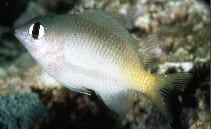 Bright-eyed damselfish (Plectroglyphidodon imparipennis) is a species of damselfish that lives in the Indo-Pacific. Adults can grow up to 6 cm. The color of this fish is white with a yellow caudal fin. The dorsal fin has 12 spines and 14-15 soft rays, while its anal fin has 2 spines and 11-12 soft rays. Adults live exclusively in the surge zone of seaward reefs. They always stay close to the shelter of small holes or sea urchin furrows in bare rock. This species mainly feed on benthic algae and small invertebrates. Eggs are demersal and stick to the substrate. Males protect and aerate the eggs.
Bright-eyed damselfish (Plectroglyphidodon imparipennis) is a species of damselfish that lives in the Indo-Pacific. Adults can grow up to 6 cm. The color of this fish is white with a yellow caudal fin. The dorsal fin has 12 spines and 14-15 soft rays, while its anal fin has 2 spines and 11-12 soft rays. Adults live exclusively in the surge zone of seaward reefs. They always stay close to the shelter of small holes or sea urchin furrows in bare rock. This species mainly feed on benthic algae and small invertebrates. Eggs are demersal and stick to the substrate. Males protect and aerate the eggs.
Although the conservation status of damselfish is barely known, it is likely not at any risk of extinction at this time. Nevertheless, according to estimated negative changes to reef health throughout the Caribbean in the next decades, it is important to continue to monitor damselfish and other species that rely on reefs as their primary habitat.
See also:
3. Surgeonfish
The Surgeonfish, also known as tangs or unicornfish, is the member of the Acanthuridae family. This is an ancient family that has survived for more than 50 million years. The distinctive characteristic of the family is the scalpel-like spines, one or more on either side of the tail, which are very sharp. The dorsal, anal, and caudal fins are large. They extend for most of the length of the body. Its small mouth has a single row of teeth for grazing on algae.
a.) Regal Blue Tang
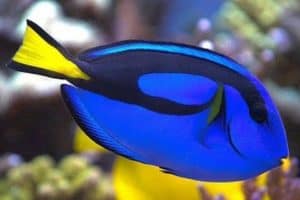 Regal blue tang (Paracanthurus hepatus), palette surgeonfish, flagtail surgeonfish, blue surgeonfish, common surgeon, doctorfish, letter six fish, Pacific blue tang, Pacific regal blue tang, blue tang, regal tang, royal blue tang, hippo tang, or wedgetail blue tang is a species of surgeonfish that lives in the Pacific Ocean, Indian Ocean from East Africa to Micronesia.
Regal blue tang (Paracanthurus hepatus), palette surgeonfish, flagtail surgeonfish, blue surgeonfish, common surgeon, doctorfish, letter six fish, Pacific blue tang, Pacific regal blue tang, blue tang, regal tang, royal blue tang, hippo tang, or wedgetail blue tang is a species of surgeonfish that lives in the Pacific Ocean, Indian Ocean from East Africa to Micronesia.
Adult regal blue tang fish typically weigh around 6 kg and are 12 to 38 cm long. Males are typically larger than females. Their oval bodies are bright blue in color with yellow pectoral fins and yellow, flag-shaped tails.
On the other hand, these fish are usually found in pairs or in small groups with 10 to 12 members. Fertilization occurs externally. Females expel their eggs into the water above the coral, and the males expel sperm.
See also:
b.) Clown Tang
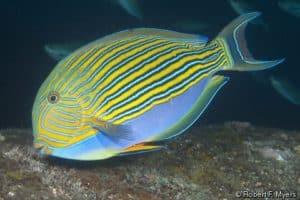 Clown tang (Acanthurus lineatus), lined tang, or blue-lined surgeonfish inhabits throughout the Indo-Pacific from East Africa to the Marquesas at depths up to 15 meters. They mainly feed on filamentous algae. This species reaches about 38 cm in length. The body has black-edged blue and yellow stripes, and yellow stripes at the top of the head. The fish is territorial. A large male protecting a feeding territory and a harem of females.
Clown tang (Acanthurus lineatus), lined tang, or blue-lined surgeonfish inhabits throughout the Indo-Pacific from East Africa to the Marquesas at depths up to 15 meters. They mainly feed on filamentous algae. This species reaches about 38 cm in length. The body has black-edged blue and yellow stripes, and yellow stripes at the top of the head. The fish is territorial. A large male protecting a feeding territory and a harem of females.
The adults may also school, and they form groups during spawning. Juveniles are solitary. The fish is mostly herbivorous but sometimes may eat crustaceans. Since this species is very beautiful, it’s high in commercial and ornamental value. In some areas, it is highly exploited, but it lives in many protected zones.
See also:
c.) Sailfin Tang
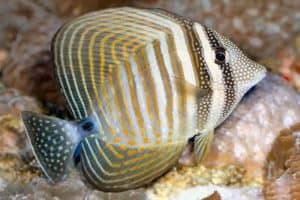 Sailfin tang (Zebrasoma veliferum) is a marine reef tang that lives at water depths of 1 – 60 m or more. This species can grow to a maximum length of 40 cm. It ranges throughout Oceania, the Indian Ocean, and the South Pacific. The sailfin tang has a disc-shaped body with a much elevated dorsal fin and a big anal fin.
Sailfin tang (Zebrasoma veliferum) is a marine reef tang that lives at water depths of 1 – 60 m or more. This species can grow to a maximum length of 40 cm. It ranges throughout Oceania, the Indian Ocean, and the South Pacific. The sailfin tang has a disc-shaped body with a much elevated dorsal fin and a big anal fin.
The sailfin tang is ornamented with broad, pale yellow bands that alternate with darker bands over its body. The bending elongates into both dorsal and anal fins. Their skin is light beige with stripes but can turn dark brown under stress. They feed especially on filamentous algae.
See also:
4. Rabbitfish
Rabbitfish is closely related to surgeonfish family. They both have a laterally compressed body and small mouths. The rabbitfish is only native to the Indo-Pacific. But there are species that have immigrated, through the Suez canal, from the Red Sea to the Mediterranean. Below are some species of rabbitfish.
a. Streamlined Spinefoot
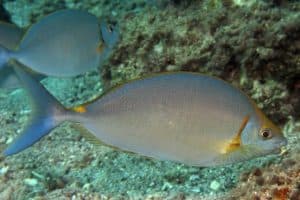 Streamlined spinefoot (Siganus argenteus) is a species of rabbitfish that lives in shallow areas of the Indo-Pacific, typically ranging from 2 to 40 m deep. It grows to 20 to 40 cm long and has venomous spines on most of its fins. This species has a blue body with a silvery underside, with dark-brown markings, dominantly spots and curved lines. It has 13 poisonous dorsal spines, seven anal spines, and silvery-yellow irises.
Streamlined spinefoot (Siganus argenteus) is a species of rabbitfish that lives in shallow areas of the Indo-Pacific, typically ranging from 2 to 40 m deep. It grows to 20 to 40 cm long and has venomous spines on most of its fins. This species has a blue body with a silvery underside, with dark-brown markings, dominantly spots and curved lines. It has 13 poisonous dorsal spines, seven anal spines, and silvery-yellow irises.
See also:
- Conservation of The Great Barrier Reef
- Ways to Stop Overfishing
- Facts of Whale Shark
- Facts of Blue Whale
Brown markings become more important when it is threatened, and its fins will become rigid and erect. They are commonly in groups of 10 to 15 grazing on algae in shallow rocky areas and reefs.
See also:
b.) Barred Spinefoot
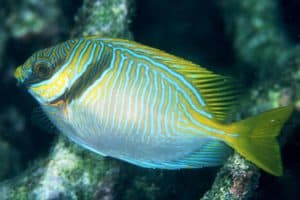 Barred spinefoot (Siganus doliatus), scribbled rabbitfish, pencil-streaked rabbitfish, barred Spanish mackerel, blue-lined rabbitfish or two-barred rabbitfish, is a species of rabbitfish native to the western Pacific Ocean where it occurs on reefs and in lagoons. This fish grows to a length of about 25 cm. This fish is yellow with a network of fine blue lines on the body, giving it a pattern that looks like a printed circuit board.
Barred spinefoot (Siganus doliatus), scribbled rabbitfish, pencil-streaked rabbitfish, barred Spanish mackerel, blue-lined rabbitfish or two-barred rabbitfish, is a species of rabbitfish native to the western Pacific Ocean where it occurs on reefs and in lagoons. This fish grows to a length of about 25 cm. This fish is yellow with a network of fine blue lines on the body, giving it a pattern that looks like a printed circuit board.
A pair of barred spinefoot spends about 80% of their time together and are seldom out of visual range. Juvenile form schools, but when they reach a length of about 7 cm they start to divide up into pairs, which may remain in the schools alongside smaller fish.
See also:
- Endangered Sea Turtle List
- Animals in the Ocean Biome
- Acidification of the Ocean
- Endangered Animals in The Ocean
- Endangered Species in Atlantic Ocean
Those are the Herbivores in the Coral Reefs you should know. Herbivores are very important for the reef as they keep thick mats of filamentous and leafy algae from smothering the corals. They keep the mat only 1 to 2 mm thick and can remove vegetation from a 10 m wide ring around the reef. These fish store feces in the small crevices where they hide, which is important in supporting the growth and diversity of corals.
See also:
- Different between the Ocean and the Sea
- Effects of Greenhouse
- Climate of the Ocean
- Threats to Sea Turtles
Coral reefs are very complex ecosystems, but luckily keeping the safe is not. Just don’t catch fish faster than they reproduce, don’t destroy the corals or pollute the water, reduce atmospheric CO2, and protect some areas as marine reserves.